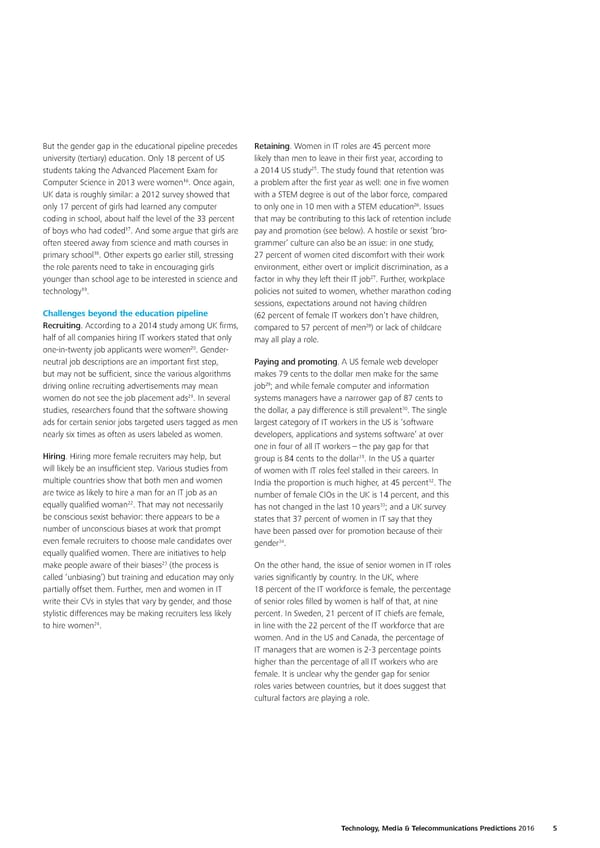But the gender gap in the educational pipeline precedes Retaining. Women in IT roles are 45 percent more university (tertiary) education. Only 18 percent of US likely than men to leave in their first year, according to 25 students taking the Advanced Placement Exam for a 2014 US study . The study found that retention was 16 Computer Science in 2013 were women . Once again, a problem after the first year as well: one in five women UK data is roughly similar: a 2012 survey showed that with a STEM degree is out of the labor force, compared 26 only 17 percent of girls had learned any computer to only one in 10 men with a STEM education . Issues coding in school, about half the level of the 33 percent that may be contributing to this lack of retention include 17 of boys who had coded . And some argue that girls are pay and promotion (see below). A hostile or sexist ‘bro- often steered away from science and math courses in grammer’ culture can also be an issue: in one study, 18 primary school . Other experts go earlier still, stressing 27 percent of women cited discomfort with their work the role parents need to take in encouraging girls environment, either overt or implicit discrimination, as a 27 younger than school age to be interested in science and factor in why they left their IT job . Further, workplace 19 technology . policies not suited to women, whether marathon coding sessions, expectations around not having children Challenges beyond the education pipeline (62 percent of female IT workers don’t have children, Recruiting. According to a 2014 study among UK firms, 28 compared to 57 percent of men ) or lack of childcare half of all companies hiring IT workers stated that only may all play a role. 20 one-in-twenty job applicants were women . Gender- neutral job descriptions are an important first step, Paying and promoting. A US female web developer but may not be sufficient, since the various algorithms makes 79 cents to the dollar men make for the same 29 driving online recruiting advertisements may mean job ; and while female computer and information 21 women do not see the job placement ads . In several systems managers have a narrower gap of 87 cents to 30 studies, researchers found that the software showing the dollar, a pay difference is still prevalent . The single ads for certain senior jobs targeted users tagged as men largest category of IT workers in the US is ‘software nearly six times as often as users labeled as women. developers, applications and systems software’ at over one in four of all IT workers – the pay gap for that Hiring. Hiring more female recruiters may help, but 31 group is 84 cents to the dollar . In the US a quarter will likely be an insufficient step. Various studies from of women with IT roles feel stalled in their careers. In multiple countries show that both men and women 32 India the proportion is much higher, at 45 percent . The are twice as likely to hire a man for an IT job as an number of female CIOs in the UK is 14 percent, and this 22 33 equally qualified woman . That may not necessarily has not changed in the last 10 years ; and a UK survey be conscious sexist behavior: there appears to be a states that 37 percent of women in IT say that they number of unconscious biases at work that prompt have been passed over for promotion because of their even female recruiters to choose male candidates over 34 gender . equally qualified women. There are initiatives to help 23 make people aware of their biases (the process is On the other hand, the issue of senior women in IT roles called ‘unbiasing’) but training and education may only varies significantly by country. In the UK, where partially offset them. Further, men and women in IT 18 percent of the IT workforce is female, the percentage write their CVs in styles that vary by gender, and those of senior roles filled by women is half of that, at nine stylistic differences may be making recruiters less likely percent. In Sweden, 21 percent of IT chiefs are female, 24 to hire women . in line with the 22 percent of the IT workforce that are women. And in the US and Canada, the percentage of IT managers that are women is 2-3 percentage points higher than the percentage of all IT workers who are female. It is unclear why the gender gap for senior roles varies between countries, but it does suggest that cultural factors are playing a role. Technology, Media & Telecommunications Predictions 2016 5
 Technology, Media & Telecommunications Predictions Page 9 Page 11
Technology, Media & Telecommunications Predictions Page 9 Page 11